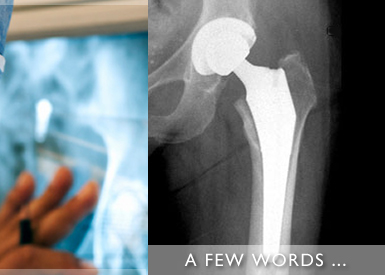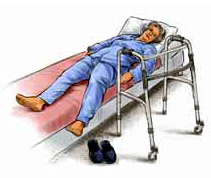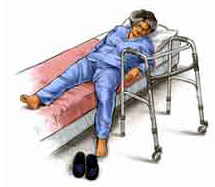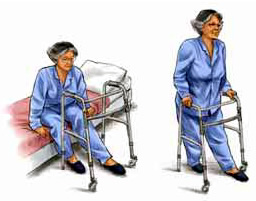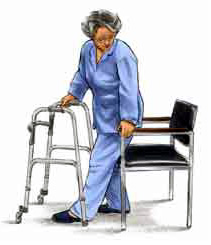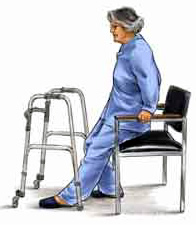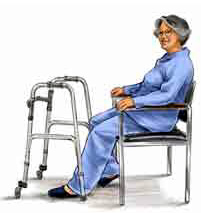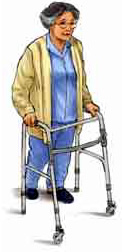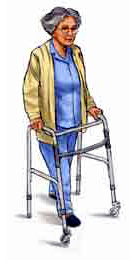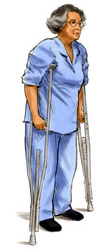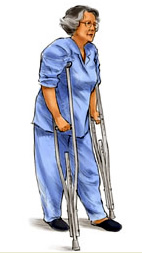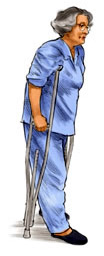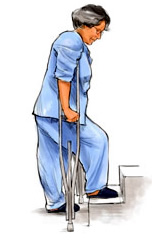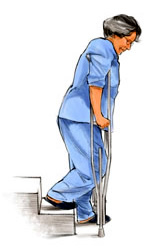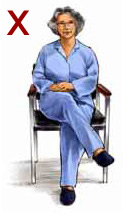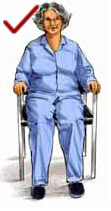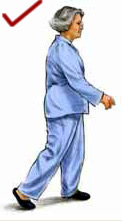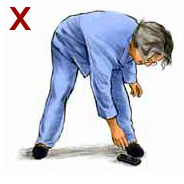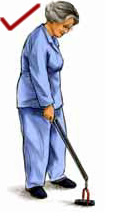|
IT IS VERY IMPORTANT THAT YOU FOLLOW YOUR SURGEON'S INSTRUCTIONS. The following suggestions should be discussed with your surgeon before your hospital discharge:
|
|
The following are some ways to incorporate movement after you have had hip replacement surgery. Discuss these techniques with your physicians and orthopeadist before attempting them. Your physical therapist may modify some of these techniques depending upon your situation (i.e., age, weight, and procedure). Only do the techniques that are recommended by your physician and/or therapist.
Step 1 Get out of the bed on the same side as your operated leg. You physician and/or physiotherapist will show you how to move your operated leg properly and will assist you the first few times while you're in the hospital.
Step 2
Step 3
STEP 1 With both hands lift and scoot the walker and place it a few inches in front of you. Be certain all four legs of the walker are down before proceeding.
Step 2
Step 3
Step 1 Place the walker a few inches in front on you and hold on to the walker firmly with both hands. Keep you hip straight and step your unoperated leg into the center of the walker. To protect your hip, avoid rotating your hip or foot. Step 2 Lean on the walker and let it support your weight. Step forward and through the walker with your operated leg. Be careful not to wrap your leg around the legs of the walker. Step 3 Lift your walker straight up (if it doesn't have wheels). Be sure to place all four of its legs down before stepping forward again.
Once your muscles are strong enough, your physical therapist and/or physician may recommend crutches instead of using a walker. Your therapist will give you guidelines on how far and how long you may walk. When using crutches, put your weight on your palms, not your armpits. Don't twist to turn, take small steps instead. Your physician and/or therapist will tell you how much weight you can put on your operated leg. Step 1 With the crutches firmly in place, place pressure on your hands, not on your armpits.
Step 2 Move the operated leg and both crutches forward at the same time. Step 3 Looking up and straight ahead, first step through the crutches with the operated leg followed by your unoperated leg.
With your crutches upright on the floor and firmly planted for support, lift your unoperated leg and place it on the step. Leaning forward on the crutches, lift yourself up. Use the crutches and your unoperated leg to support your weight. Now lift your operated leg up onto the step. You may want to have someone help you the first few times until you become comfortable with stairs.
Place your crutches and your operated leg on the lower step. Use the crutches for balance and lower yourself carefully down onto the step moving the crutches as you move the operated leg. Again, you may wish to have someone assist you the first few times you try this.
Avoid Risky Movements
Don't let your knee cross the midline of your body. Rather, sit with both feet on the floor, with your knees six inches apart
Don't plant your foot and rotate your new hip inward. Rather, turn both your feet and your body.
Don't bend all the way over from the waist Rather, use a device, such as a long-handled grabber to reach down.
|

